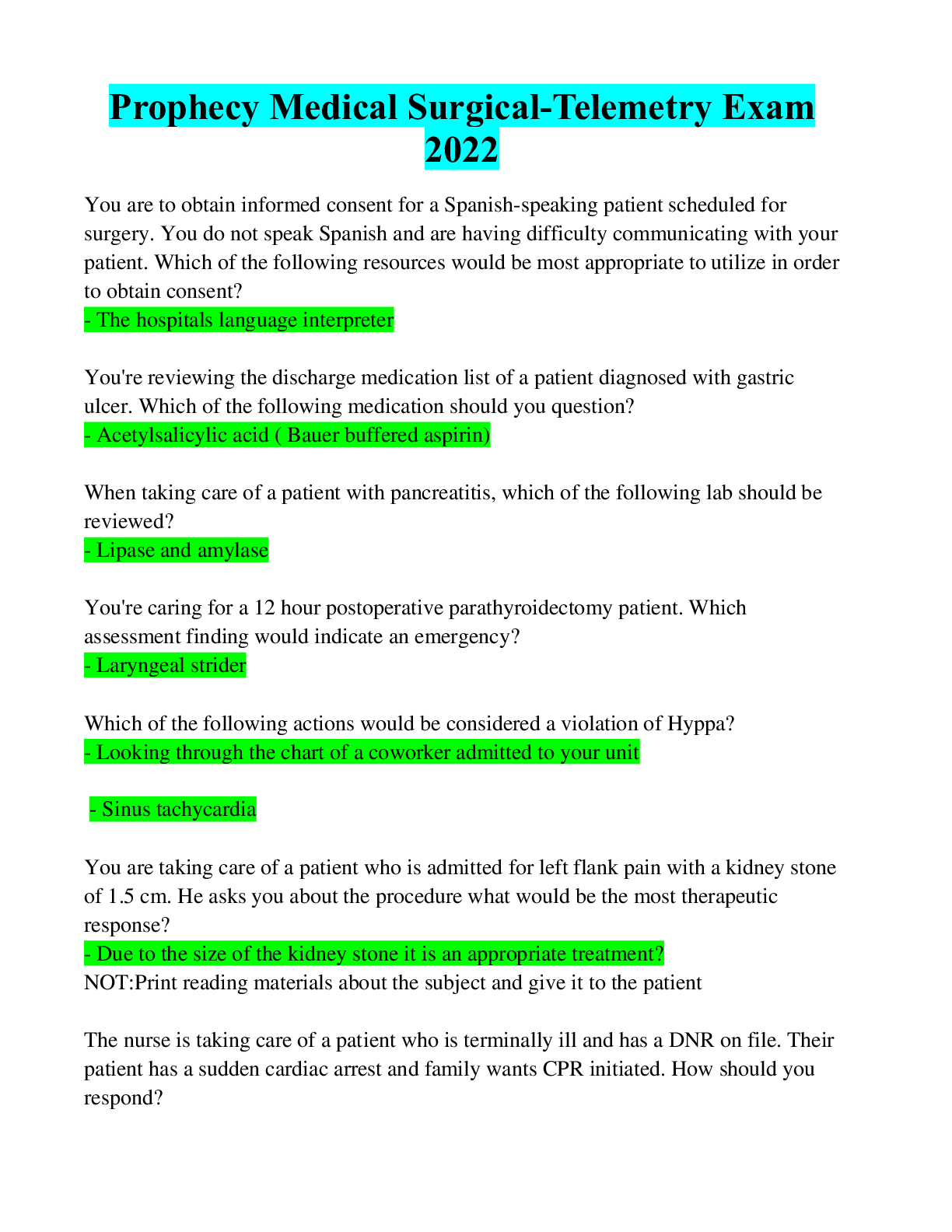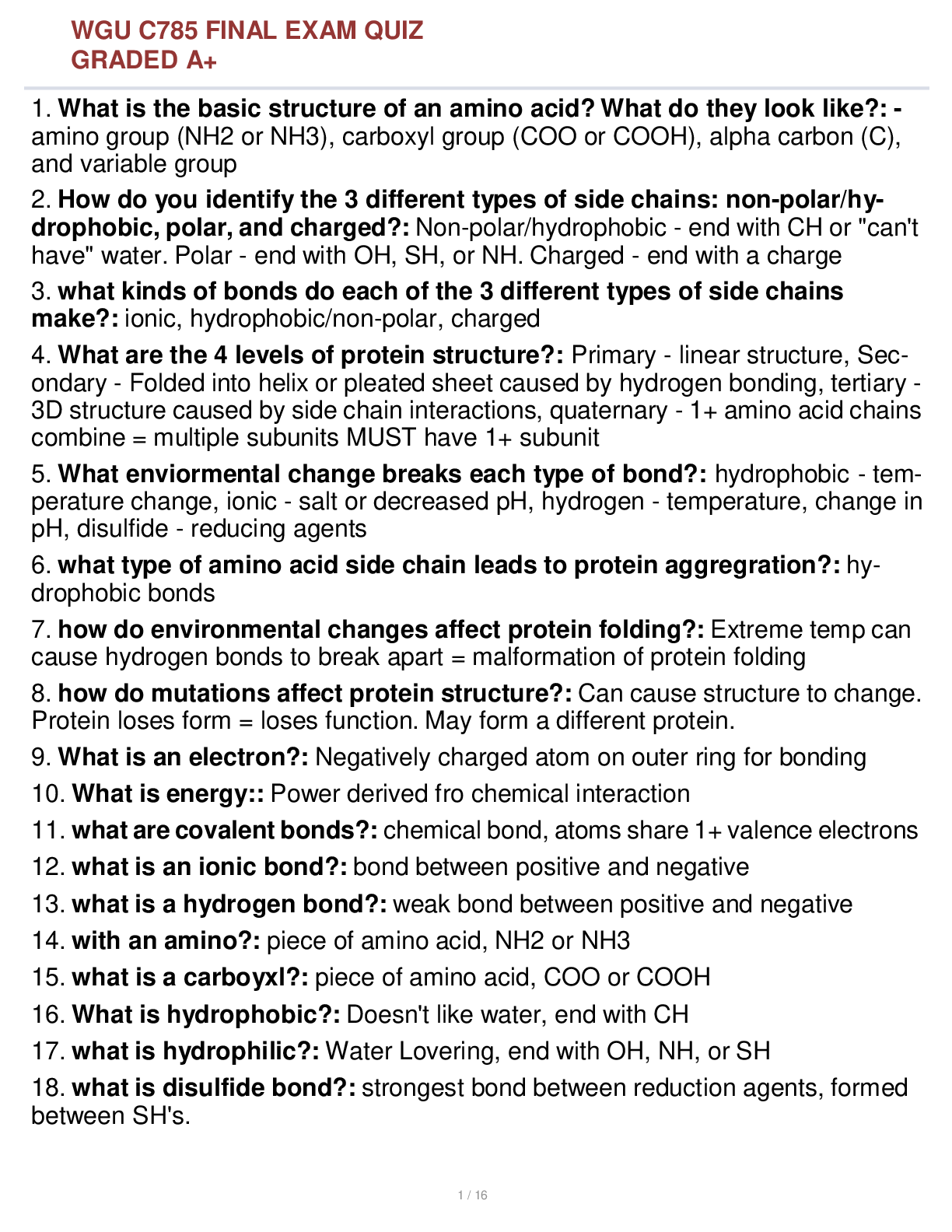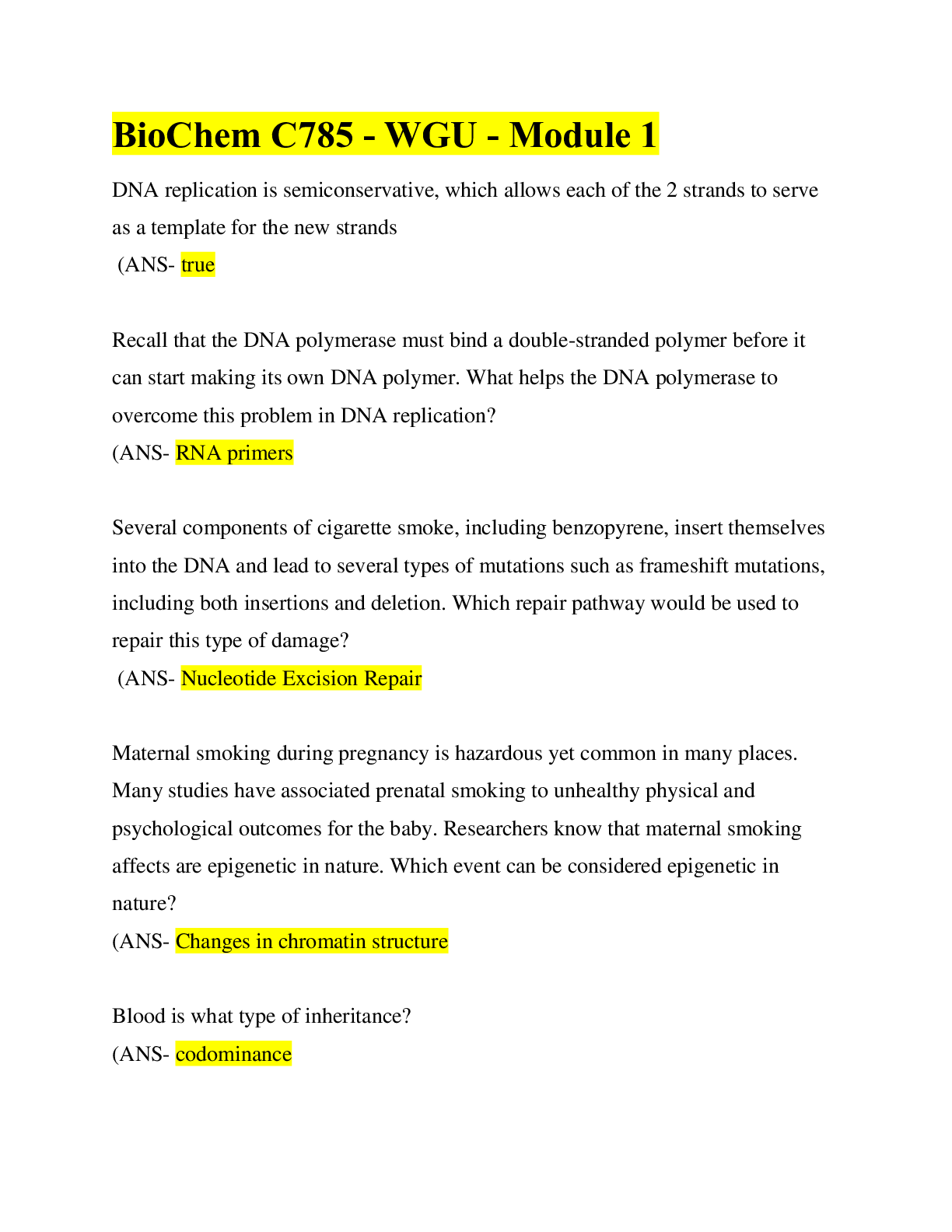BioChemistry > STUDY GUIDE > BIOCHEM C785 2 OA readiness check. (All)
BIOCHEM C785 2 OA readiness check.
Document Content and Description Below
What is the complementary sequence to 3’ ATG CGA ATA 5’? (0/1 Points) 3’ TAT TCG CAT 5’ 3’ TAC GCT TAT 5’ The correct answer is 3' TAT TCG CAT 5'. Remember complementary means “Match... ing or Pairing” You have to remember to pay attention to your numbers as well as your letters (A-T, G-C, 5'-3'). The correct answer is 3’ ATG CGA ATA 5’ (original sequence) 5’ TAC GCT TAT 3’ (complementary sequence) But we asked for it in the 3’ direction, so mirror answer to give correct answer: 3’ TAT TCG CAT 5’ If you chose 3' TAC GCT TAT 5', this is incorrect. Although the nucleotides are in the correct order, the 5' and 3' are in the wrong place. DNA strands that are complementary run in opposite directions. This means that if one strand starts with a 3', the the complementary strand must start with a 5'. If none of the answer choices give the correct answer in 5' ---> 3', then you need to write its mirror, which will run from 3' ---> 5'. 3’ GAT AGC ATA 5’ 5’ ATA AGC GTA 3’ 2 Which amino acid sequence would result from this Coding DNA strand? 3’ ATG CAG ATA 5’? (1/1 Points) Tyr Val Tyr Ile Gln Ile Ile Asp Val The correct answer is Ile Asp Val. We are starting at the coding strand, and have to remember the relationship between coding DNA and mRNA. These two strands are noncomplementary and parallel. So we copy the coding strand , change T ---> U, and then write the mRNA sequence: 3’ ATG CAG ATA 5’ coding 3’ AUG CAG AUA 5’ mRNAMirror by changing orientation: 5’ AUA GAC GUA 3’ Read chart Ile Asp Val (chart is in direction of 5' ---> 3') Leu His Lys 3 Which amino acid sequence would be made from this template DNA strand? 5’ TAT TAC CGA 3’? (1/1 Points) Tyr Tyr Arg Ile Met Ala Ser Val Ile The correct answer is Ser Val Ile because 5’ TAT TAC CGA 3’ template is complementary and antiparallel so 3’ AUA AUG GCU 5’ but it is in the wrong orientation, so mirror 5’ UCG GUA AUA 3’ and read the chart Ser Val Ile Ser His Gln 4 Which of the following are the correct components for a PCR reaction? (1/1 Points) dNTPs, Primer, RNA Polymerase, template RNA dNTPs, Primer, DNA Polymerase, template DNA The correct answer is dNTPs, Primer, DNA Polymerase, template DNA. Notice that all components are about DNA. The Primer is even a DNA Primer. ATP, Primer, mRNA polymerase; template mRNA Acetyl CoA, RNA primer, DNA Ligase, Template phosphate 5 Assuming 100% reaction efficiency, how many DNA copies will be produced after 5 PCR cycles, if we begin with 1 DNA template? (1/1 Points) 16 32 The correct answer is 32. 2x2x2x2x2=32 64 10 6 Which of the following would represent a silent mutation if this is the original sequence: 5’ AUC GUA ACA 3’? (1/1 Points) 5’ AUC GGA ACA 3’ 5' AUA GUA ACA 3' The correct answer is 5' AUC GUA ACA 3' Ile Val Thr 5’ AUG GUA ACA 3’ 5’ AUC GCA ACA 3’ 7 If the original coding sequence is 5’ CGA TAC TTC AGA 3’ and it is mutated to 5' CGA TAT TTC AGA 3', what type of mutation would have taken place? (1/1 Points) Silent The correct answer is silent mutation. The nucleotide sequence changes, but it codes for the same amino acid. The coding sequence 5' TAC 3' corresponds to the mRNA sequence 5' UAC 3' (Tyr), and the coding sequence 5' TAT 3' corresponds to the mRNA sequence 5' UAU 3' (Tyr). Since the C changed to at T, this is a point mutation. If the point mutation results in the same amino acid in the new sequence as in the original sequence, the point mutation is a silent mutation. Missense Nonsense Insertion 8 Huntington's is an autosomal dominant disorder. Which of the following chromosome pairs would be inherited by a person with Huntington's Disease? (Yellow box = Dominant allele, Green box = Recessive allele) (1/1 Points) Option 1 The correct answer is Option 1 because an autosomal dominant disorder would be inherited on numbered chromosomes, not sex chromosomes X or Y. Also, at least one dominant allele (yellow box) needs to be present for the individual to have the dominant disease. Option 2 Option 3 Option 4 9 The pedigree below tracks Duchenne Muscular Dystrophy (DMD) through several generations. What type of inheritance does DMD express? (1/1 Points) Autosomal dominant Autosomal recessive X-linked Dominant X- Linked recessive The correct answer is X- linked recessive because parents (carriers) do not have it (II-5- 6) but a child does (III-5). You will get the same result if you consider parents (carriers) (I-1-2), who do not have the trait, but a child does (II-3). A third option that gives the same result (X-linked recessive) is by considering parents (carriers) who do not have the trait (III-1-2), and their child does (IV-1). The pattern is recessive because the selected parents are carriers, and it is X-linked because only males have the trait. 10 If you had a mother who is homozygous for a recessive disease, and a father who is a heterozygous carrier, what percentage of children will have the disease? (1/1 Points) 0% 25% 50% The correct answer is 50%. Homozygous recessive: aa Heterozygous: Aa When you see "percentage" or "probability," think Punnett square. 50% of the children would be expected to be Aa, and 50% of the children would be expected to be aa. 75% 100% 11 Which of the following describes an epigenetic change? (0/1 Points) Denaturation of template DNA to facilitate primer annealing. Increased methylation of the promoter region of a tumor suppressor gene in a developing fetus. Thymine dimer formation resulting from UV radiation. Mismatch mutation caused by mistakes made by DNA Polymerase during replication. The correct answer is "Increased methylation of the promoter region of a tumor suppressor gene in a developing fetus." 12 Rett syndrome is a brain disorder that occurs almost exclusively in females, causing severe deficits in language, learning, coordination and other brain functions. Decreased expression of the MECP2 gene causes Rett syndrome. Which of the following scenarios correctly describes how Rett syndrome could be developed? (1/1 Points) A DNA-binding protein blocks RNA Polymerase from binding to the promoter sequence, facilitating the transcription of the MECP2 gene. Transcription factors are unable to bind to the transcription start site of the MECP2 gene because nucleosomes are tightly packed together. The answer is "Transcription factors are unable to bind to the transcription start site of the MECP2 gene because nucleosomes are tightly packed together." Think "increased space gives increased access and increased expression." Gene expression is increased when nucleosomes are widely spaced and transcription factors and RNA Polymerase are able to bind to the transcription start site of the gene. In this question, decreased expression is resulting from decreased space between the nucleosomes, so the RNA Polymerase and transcription factors have decreased access to the transcription start site of the gene. Transcription activators cause nucleosomes to separate, exposing the MECP2 gene. RNA Polymerase binds to the MECP2 gene and begins translation. 13 What happens when the incorrect base is added during the synthesis of a DNA strand in DNA replication? (1/1 Points) The homologous chromosome is used to replace the incorrectly added base with the correct one. DNA Polymerase removes the incorrect base and adds in the correct base. The correct answer is "DNA Polymerase removes the incorrect base and adds in the correct base." DNA Polymerase repairs mismatch errors that occur during DNA replication. Thymine dimers occur. Distortion of the double helix occurs and is repaired by RNA Polymerase. 14 What is the correct definition of nucleotide excision repair? (1/1 Points) Removal of a single damaged nucleotide Damage to a few or several nucleotides are identified, then many nucleotides are removed and all are replaced to repair the DNA segment The correct answer is "Damage to a few or several nucleotides are identified, then many nucleotides are removed and all are replaced to repair the DNA segment." In nucleotide excision repair, several nucleotides are removed whereas, in BER (base excision repair), a single nucleotide is removed. Required when there are breaks in the double stranded DNA strand which causes discontinuity in both strands Insertion of a thymine dimer [Show More]
Last updated: 2 years ago
Preview 1 out of 20 pages

Buy this document to get the full access instantly
Instant Download Access after purchase
Buy NowInstant download
We Accept:

Reviews( 0 )
$11.50
Can't find what you want? Try our AI powered Search
Document information
Connected school, study & course
About the document
Uploaded On
Jun 08, 2021
Number of pages
20
Written in
Additional information
This document has been written for:
Uploaded
Jun 08, 2021
Downloads
0
Views
51








.png)

.png)


